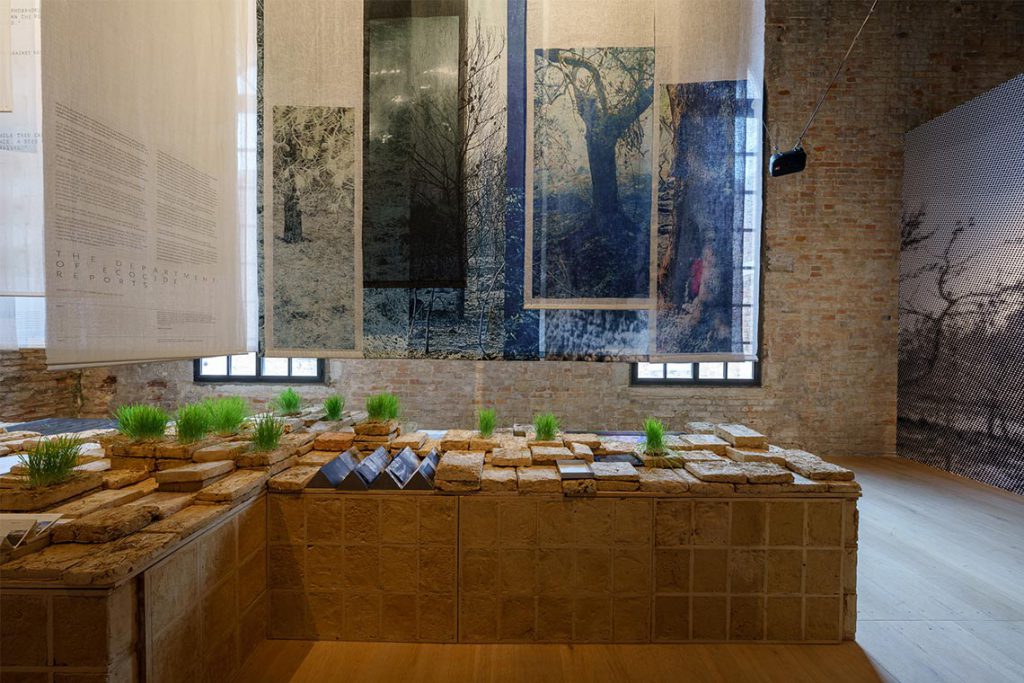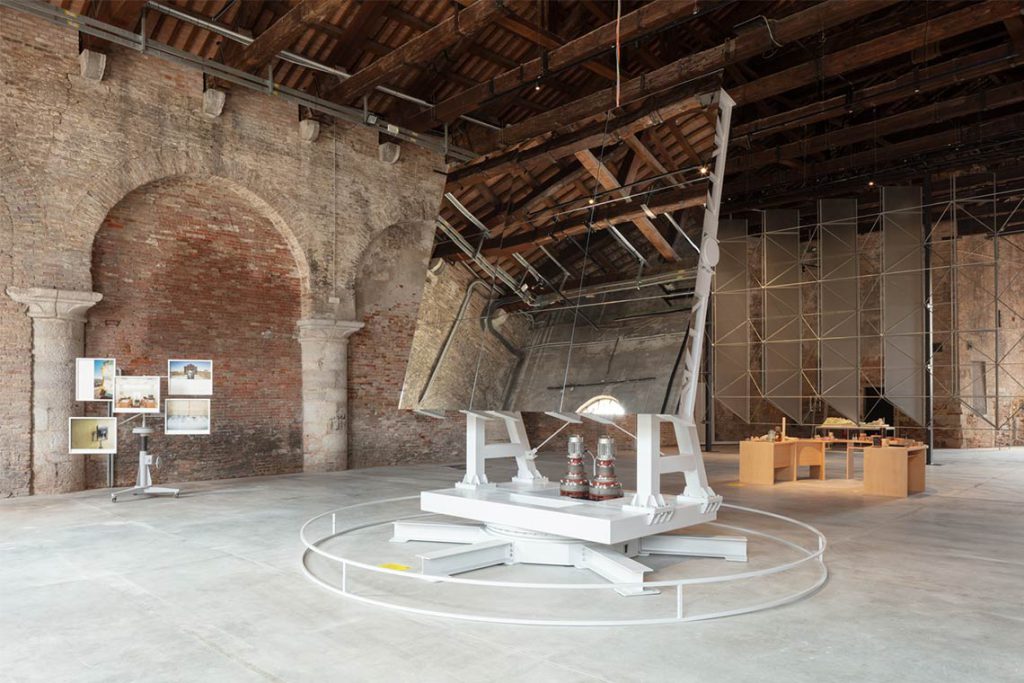Bahrain lands top prize for the second time while other Middle Eastern nations spend lavishly but risk being clunky and over-didactic.
The headline story from this year’s Venice Biennale of Architecture – the nineteenth edition of an event that arguably takes second billing to its more celebrated art sibling – is that the award for best national participation went to Bahrain. It is the second time the Kingdom has landed the Golden Lion, previously winning in 2010, and this year’s offering was perhaps crowned because it was as much a welcome installation for the visiting jury as it was a critical presentation. Entitled Heatwave, it discusses how urban environments can contend with rising global heat levels. This may sound dry, but it is anything but, with a room-filling, relaxing landscape of welcoming soft cushions and a lowered air temperature. We will return to Bahrain later, but to truly understand its embrace one first needs to navigate the many, often dense, presentations that make up the biennale.
The biggest trap for architectural exhibitions is to present a publication or model. Ideas of building and landscape can be complicated, and a long history of architectural publishing and model making is evidence of the clear preference of communication (at least, after actually making a building…). Yet these are both also specific and evolved forms, distinct from pure exhibition. Egypt has fallen into this trap. Infographics and images of many of the nation’s oases wrap the large walls, with videos presenting documentary footage and dense caps-locked wall text fighting its way through ideas of harmony and balance between desert and growth. Filling the centre of the room is a 10-metre-long see-saw in which the public can move blocks with labels on: “GREENHOUSES”, “ARTISAN CRAFT”, “AGRI-TOURISM”. Some are good, some bad, some old-industry, some nu-industry, but all are clunky in physicality and metaphor.
Lebanon’s space is far smaller, but also struggles to land as an exhibition. Its ingredients are worthy and important, dealing with microbial remediation, repairing a landscape damaged by bombs and crushed by tanks, but the exhibit is largely formed of drawings and information that would be better presented in a book. Meanwhile, Turkey has a huge space at the biennale, which can be a curse more than luxury if used badly. A group show with more than 20 participants, it considers soil as a carrier of both ecological and cultural memory. There are interesting moments, but altogether it presents as a trade show showcasing models of potential future industry. Here, architecture is leveraged more as a nationalistic-future-income and less as artistic exploration for an event such as Venice.

Oman has gone a stage further. Instead of presenting many small models, the whole pavilion has been turned into a single 1:1 simulacra of potential architectural form. Taking cut-outs and linguistic approaches of various national vernaculars from details of mandoos storage chests to historic doors, a large parametric form has been assembled. Fun enough to walk through, if a bit derivative of Hadid-esque form-finding of over a decade past, the nonsense words on the wall presenting it as “symbols constructed from its tools” and “diagrammatic abstraction … translated into spatial strategies” only serve to add baggage to an already heavy approach.
Of course, all national presentations at something like a biennial are forms of soft power. It is the very historic function of the event and has only become more political and nationalistic in the century-plus since the first Venice Biennale in 1895. Some pavilions are more up front about it than others, however, barely disguising the approach under cultural subterfuge. Azerbaijan does just this, filling its spaces with a series of models and wall panels that describe recent and proposed projects. “Azerbaijan is steadily becoming a model of sustainable development, where visionary projects and a profound respect for history converge to shape a brighter, greener future” reads the very PR-smoothed wall text. The projects are interesting enough, but this is really just a state-funded brochure more than an exhibition worthy of the world’s primary cultural exploration of one of the world’s oldest crafts.
Saudi Arabia takes a similar approach, albeit with a lot more creativity and nuance. Its large space in an Arsenale shed has an experienced curator, Beatrice Leanza, who has helped shape and hone a well-paced study of The Ulm Slaim School, with works from a collaborative initiative from Syn Architects, founded by Alissa and Nojoud Alsudairi, exploring the loss and displacement of Najdi architecture in Riyadh. Long corridors formed of canvas walling provide a mixed installation of objects, photography, methodological approaches, drawings and mappings, including: Mansour Alsofi’s self-initiated saudiarchitecture.org archiving heritage in a growing economy; Shamalat cultural hub, re-purposing a vernacular mud house into a cultural centre; and Maha Malluh’s simple installation of supermarket-bought household goods, which adds humanity and mundanity when a biennale can often be about grand gestures, expensive projects and futuristic ambition.
Qatar – for one of the final times before its own permanent pavilion is ready – fills the grand rooms of the Palazzo Franchetti with a well-funded, immaculately presented exploration of ‘home’. While a somewhat bland and safe theme, it is nonetheless rich in content, boasting sublime Hassan Fathy drawings; nineteenth-century timber doors and frames; a rich tapestry by Sayed Mahmoud-Ikram Nosshi and Wissa Wassef Studio of the Egyptian countryside; and a variety of extravagant architectural models, including one of Jean Nouvel’s National Museum of Qatar that likely cost more than some entire buildings.
Oddly, for an exhibition about the idea of the home, there is hardly any mention of Qatar’s future biennale pavilion, designed by Lebanese-born Lina Ghotmeh and destined to take a central position in the Giardini site. The spot it will be constructed on is temporarily occupied by a Yasmeen Lari-designed mud and bamboo community centre, on loan from the Art Mill Museum, which will host events over coming months. A single image on a panel in the building shows a render of Ghotmeh’s design.
With the biennale – and the architecture sector more widely – woefully underrepresented in terms of Middle Eastern presence, and with assumptions, clichés and colonial-rooted beliefs still holding firm, the superb polished displays mounted by Saudi Arabia and Qatar are important. Yet there is room too for a biennale national presentation that is looser and less dogmatic in terms of being a tool of carefully calculated soft power. Perhaps one with a greater sense of play, artistic exploration and criticality over waxed image-making.
Kuwait tries just this approach, although its efforts are hampered by the sense of a tighter budget for the curatorial team and by the choice of a venue so far off the beaten track that it is unlikely many visitors will happen across its interesting offer. A research project that sometimes struggles to escape the ‘publication’ approach, there is enough in the presentation from curators Mohammed Kassem, Naser Ashour and Rabab Raes Kazem to intrigue artistically as well as preach pedagogically. A reliance on abundant resources over sustainable practices is explored through a series of rubble fragments, critiquing the space between innovation and industrial standardisation, and decision-maker intent and implementation of policy. While heavy in terms of its idea, it achieves a fairly light touch through a display made of petrochemical byproducts and which can be re-used for future cultural events.

Azza Aboualam’s curation for the UAE looks at food production and architectural ideas at both large and local scales, presented playfully as an ongoing research project of architecture as kit-of-parts, rearrangeable for different crops in a changing climate. It can be engaged with as a publication into the research, but in a biennale dense with information, a simply aesthetic experience is extremely welcome. In the Giardini, neighbouring Qatar’s new site, the temporary Manameh Pavilion offers the same sensation. While a non-national component of the biennale, and more a promo for funders Expo City Dubai, it succeeds where other presentations fail by simply offering visitors a welcoming architectural experience and space of respite. A simple raised and sheltered platform, conceived by Emirati creative director Amna Abulhoul and curated by Ahmed and Rashid bin Shabib, it is relentlessly popular with visitors as a meeting point, lunch spot and somewhere to get away from the didactic displays and simply enjoy being in architecture.
One of the best pavilions for marrying critical discourse and deep architectural knowledge with a knowingly and sparingly curated artistic installation is that of Uzbekistan, overseen by the Uzbekistan Art and Culture Development Foundation. GRACE Architects present a small fraction of their deep research into Tashkent Modernism – currently awaiting a decision on UNESCO heritage status – by presenting details of the enormous Heliocomplex. A scientific structure built in 1987 in the hills outside Tashkent, an array of mirrors reflects the sun into a gigantic concave mirror that, in turn, channels rays to a small furnace where temperatures reaching 3000°C are used to test new materials. This display could have easily been a minute study of the building, its history and potential for a solar-infused future, but the Arsenale shed is a sparely curated installation of elements – a single huge mirror, a geometric façade, artwork from the building and fragment materials – that allows space for imagination and creativity to breath where other pavilions nervously relay a mass of information.
It is welcome to see such clarity, confidence and understanding of what makes a strong exhibition, which is also the case with the Golden Lion-winning Bahrain pavilion. To enter the room full of soft pillows, to feel the cooled air, is an extremely welcoming invitation in such a heavy biennale – where other pavilions bombard with text, here the first communicative gesture is sensorial. There are dense research and critical ideas underpinning the project, all presented superbly in a publication that is generously scattered around the installation for resting visitors to pick up and peruse. The space is a mock-up prototype of a proposal for public cooling spaces that do not rely on energy-intensive systems. While air temperature in the region fluctuates to incredibly high (and increasing) temperatures, underground is cooler and steadier. Here, hot outdoor air would be funnelled through buried pipes, lowering in temperature before being released above across a canopy system. Underneath, a public space is not only cooled but creates a moment of social coming together and community.
Such a sculptural, performative approach is an entirely different way to impart ideas than through great wall panels of text or didactic displays of models and architectural drawings. As one of the few pavilions in this edition of the biennale to offer a moment of pause, rest and separation (notably, Ireland and Singapore also offer spaces of retreat) it is even more powerful and impactful. So it is not entirely unexpected that a judging panel who had to examine all 66 national participations in a very short period of time awarded their prize to the presentation that allowed them a moment of recovery.
The Venice Biennale of Architecture runs until 23 November



